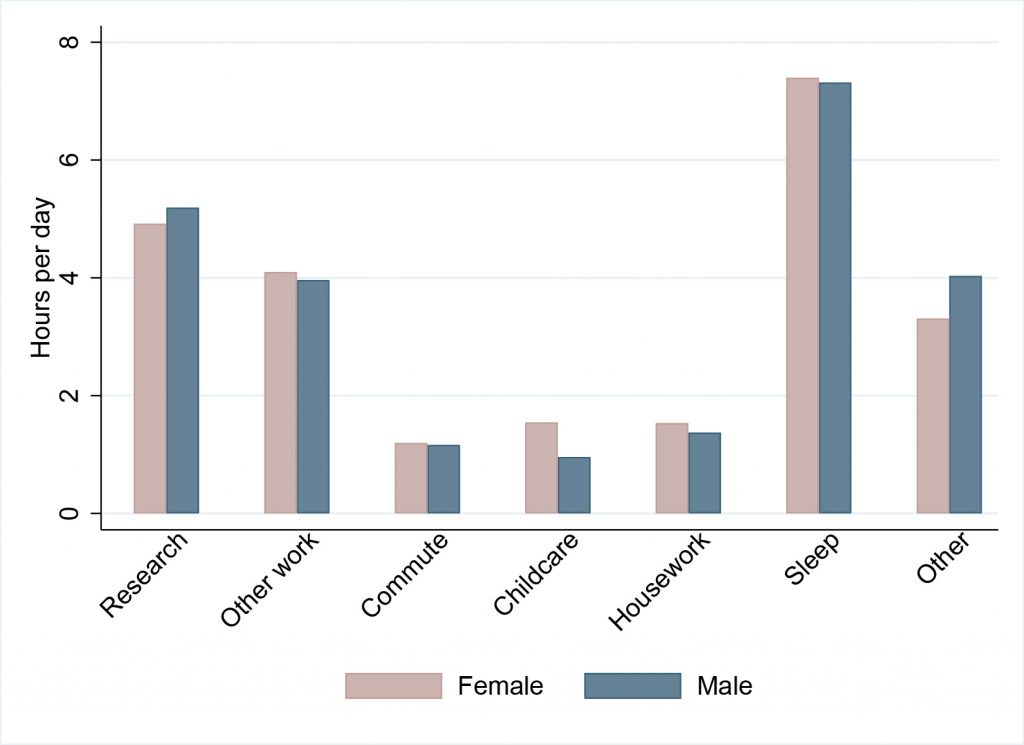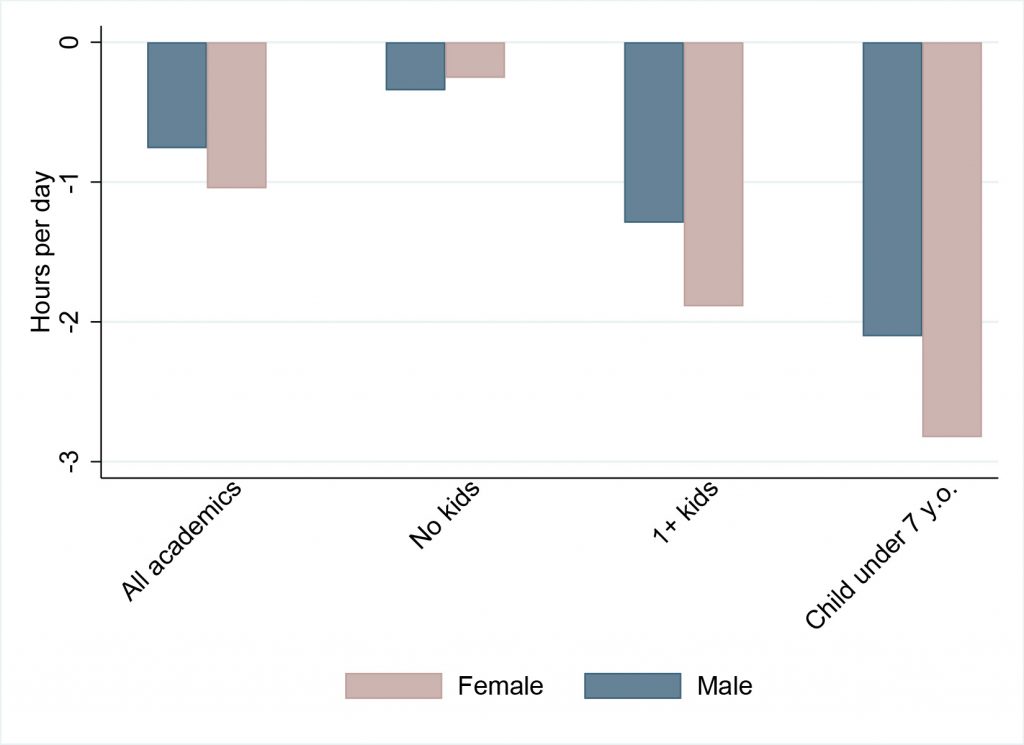A new paper finds that academics who are parents to young children, and especially mothers, have lost a significant amount of research time that has been displaced by childcare and housework during the Covid-19 pandemic.
Editor’s note: A shorter version of this post was previously published on Medium.
The rapid spread of the Covid-19 pandemic and subsequent countermeasures, such as school closures and the shift to working from home, are disrupting economic activity around the world. As with other major economic shocks, there is a threat of increased inequality between groups differentially affected by these disruptions. Early research shows that the pandemic has disproportionately affected women’s employment relative to men’s, with women being more likely to lose their job and drop out of the labor force. But what about the effects of Covid-19 disruptions on men and women who are still working?
To shed light on this question in our new paper, we administered a global survey to a diverse group of academic researchers to understand how Covid-19 has changed their allocation of time. To understand the mechanisms behind any differential changes, we also asked about respondents’ circumstances, such as the number and ages of children in the household. Nearly 20,000 active researchers, of whom 40 percent were female, fully completed the survey, which was administered in May and June of 2020. Using these data, we uncover a disparate impact of the pandemic by gender and an important mechanism behind it: parents of young children, and especially mothers, have lost a significant amount of research time that has been displaced by childcare and housework.
Studying the effects of the pandemic on academics is important for at least two reasons. First, gender gaps among academics have been historically large, in terms of rank, research output, and impact. A widening of this gap could reduce diversity in academia, potentially leading to less innovation and lack of role models for female students. Second, academic researchers are also relatively unlikely to lose their job due to Covid-19, so we can study changes in time use independent of changes in employment status.
“Parents of young children, and especially mothers, have lost a significant amount of research time that has been displaced by childcare and housework.”
Figure 1 shows how male and female academics allocated their time to each major life activity per normal workday prior to Covid-19. The average researcher in our sample worked about 9 hours per workday, not including commute time (an additional 70 minutes per day, on average). Men and women worked comparable amounts on average, but women spent about 30 minutes less per workday on research and more time on other job responsibilities such as teaching, advising, and administrative tasks. Women also spent about 40 more minutes on childcare than men, while men spent about 40 more minutes on other activities, a category that implicitly includes leisure, exercise, and uncompensated work outside the home (e.g., grocery shopping or car maintenance).
In other words, prior to Covid-19, male and female academics in our sample spent comparable amounts of time on paid work but differed in how they allocated their time outside of formal employment.

The pandemic affected both male and female researchers, reducing daily work hours by about 45 minutes for men and by about one hour for women (see Figure 2). Almost all of this decline was driven by a reduction in time spent doing research and was accompanied by an increase in childcare and other housework: the time women spent on childcare activities increased by about 80 minutes per workday, compared to 50 minutes for men. Additionally, as most academics stayed home, average commute times dropped from about 70 minutes to about 10 minutes per workday. Prior to the Covid-19 disruptions, less than one percent of respondents reported zero minutes of commute time on a typical workday; after the onset of the pandemic, 86 percent of respondents did.
The declines in work and research time were not universal: about 25 percent of respondents reported spending more time on research post-pandemic and about 34 percent reported spending more time on other work tasks. Notably, the probability of reporting an increase in work time did not differ substantially by gender: about 36 percent (42 percent) of those who reported spending more time on research (other work tasks) were women, which is similar to the overall proportion of women in the sample (40 percent).

These gendered declines in work time are fully explained by the presence of children in the household (Figure 3). There were no meaningful differences in work time declines for childless men versus women. If anything, childless women’s work time decreased by slightly less than childless men’s (15 versus 20 minutes, respectively). But among researchers with kids, the differences in declines were much more extreme. While men with children worked about 75 minutes less per workday due to Covid-19 disruptions, women with children worked almost two hours less per workday.
The most severe work disruptions occurred in families in which the youngest child was under 7 years of age, with fathers of young children reducing work time by two hours and mothers reducing it by nearly three hours per workday. These changes in work time were more than fully offset by increases in childcare time for both mothers and fathers, but the gender gap in time spent caring for children increased by one hour compared to before Covid-19. Because mothers already spent more time in childcare than fathers, this increased the gender gap in childcare time to over two hours per work day.

Our results may underestimate the adverse effects of the pandemic on academics with children. For example, parents supervising children at home may engage simultaneously in childcare and research activities, making them less productive in both. Academics in the most extreme pandemic situations may have been less likely to participate in our survey. The data also do not allow us to measure changes in overall well-being or mental health of either parents or their children, or other potential negative effects of the pandemic. Our survey was conducted relatively early in the pandemic (May-June 2020), so more research is needed to fully capture its lasting effects on parents. So far, our work shows that, like in many other occupations, Covid-19 has disproportionately disadvantaged academic mothers relative to academic fathers and childless individuals.
Gender gaps among academics have been historically large, in terms of rank, research output, and impact, and these gaps appear to have widened since the onset of Covid-19. In the long run, the disproportionate loss of research time could mean even further under-representation of women in academia. Consequences could include fewer innovations and breakthroughs in research, less attention directed to topics of importance to underrepresented groups, and fewer students whose professors and mentors look like them. Our findings suggest that increased childcare availability is central to narrowing the gender gap in academia.






